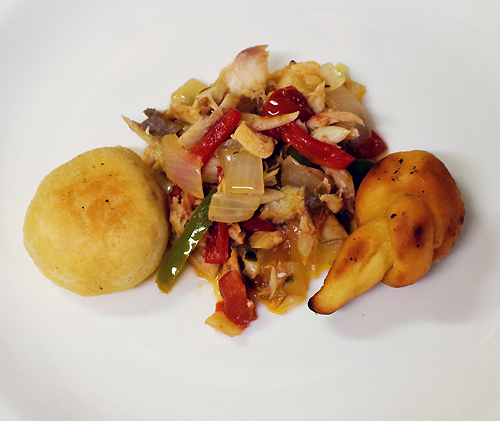
LLUIDAS VALE, St. Catherine ルイダス・ヴェール、セント・キャサリン

スマホでご覧の方へ:英文の後に日本語翻訳が表示されます。スクロールしてお読み下さい。
Pickled mackerel
This is the eleventh instalment in our “Food I fondly remember” interview series which is aimed at introducing Japanese to odds defying Jamaican and their Jamaican soul foods which many Japanese have never experienced but are really worth trying.
Featured in this our eleventh interview is Fitz Jackson – a servant of the people of Jamaica, an entrepreneur, an astute business consultant and a man on a mission to revolutionize the way Jamaica’s most popular dish is enjoyed by Jamaicans and non-Jamaicans alike. Fitz has truly whet the appetite of Americans of all walks of life who keep clambering for more of his special treat which has seen both his scale of operation and his market share growing exponentially year on year.
Fitz hails from the hilly interior of Jamaica’s largest parish, Saint Catherine from a quaint rural town named LLUIDAS VALE located close to Ewarton and Linstead. Lluidas Vale along with Ewarton and its environs were very progressive rural towns in the heydays of the bauxite-alumina mining era. In addition to the huge development and economic benefits these towns enjoyed from their involvement in bauxite mining and alumina processing, the soil in the surrounding areas were also prime for growing crops of all variety – a fact cemented in Jamaican folklore in the Linstead Market song, “Carry Mi Ackee Guh A Linstead Market” and the seminal time treasured poem by Daisy Myrie, “The Market Woman”. (https://www.facebook.com/159834224571667/photos/the-market-woman-by-daisy-myrie-down-from-the-hills-they-comewith-swinging-hips-/270638663491222/). Lluidas Vale was back then a sugar belt farming town. Sugar cultivation and production in the 1950s, 60s and 70s was arguably one of the Jamaica’s top 5 industries and thus a main spoke in the wheel of the Jamaican economy by way of employment, infrastructure and development and foreign exchange earnings.
Fitz was raised in a very tightly knit, loving and caring family of eight children – evenly balanced gender-wise. He recalls his parents being entrepreneurs. His mother played the lead role in managing the family’s modest wholesale and retail boutique which specialized mainly in footwear and female and children’s clothing. The family’s income was further supplemented by their modest poultry and livestock rearing. One could surmise that this was the catalyst that led to Fitz’s path into him starting his entrepreneurial enterprise later on in life.
His early schooling was at Lluidas Vale Primary before transferring to Point Hill Primary School in grade 8. He was 10 years old at the time. (Undoubtedly, many of you reading this interview might be a bit perplexed thinking the numbers do not quite add up. Do you recall in interview #7 with Gillian who was always the youngest in her class because she was born in December? It was the same for Fitz, himself being born in September). Back then, the grading system was very different to what it is today. Basic, Infant and Primary schools were essentially one (9 grades).
In present day Jamaica the early childhood school system starts with children aged 3 attending Basic School (Pre-School). At age 4, they move on to Infant School (Kindergarten) where they spend 2 years (2 grades). After Infant School, they enter Primary School (Elementary School) at age 6 where they study for 6 years (6 grades). After Primary School, Jamaicans go on to High School (Junior and High School combined) for another 5 years. Children who are born from September to December are eligible to attend school the same time as children who are born from January to August in their same birth year. The school year starts in September.
塩鯖と揚げダンプリング
日本人の多くが経験したことのないジャマイカのソウルフードを紹介するインタビューシリーズ「Food I fondly remember」の第11弾です。
第11回目となる今回のインタビューは、ジャマイカの人々に仕え、起業家であり、洞察力の高いビジネスコンサルタントであり、ジャマイカで最も人気のある料理を世界中の人が楽しむ方法に革命を起こすことを使命としているフィッツ・ジャクソン氏の登場です。フィッツは、彼の商品をもっと食べたいというアメリカ人の食欲を刺激し、彼の事業規模と市場シェアは年々飛躍的に拡大しています。
フィッツはジャマイカ最大の教区であるセント・キャサリンの丘陵地帯の出身で、ユワートンの近くにあるルイダス・ヴェールという趣のある田舎町に住んでいました。ルイダス・ヴェールは、ユワートンとリンスティッドその周辺地域とともにボーキサイト・アルミナ採掘の全盛期には非常に進歩的な田舎町でした。これらの町はボーキサイト採掘とアルミナ加工の関与から享受した巨大な開発と経済的利益に加えて、周辺地域の土壌はあらゆる種類の作物を栽培するのに適していました-“Carry Mi Ackee Guh A Linstead Market (リンスティッド・マーケットにアキー売るためにを持ち込む)”とデイジー・マイリー(Daisy Myrie)の歌、”The Market Woman”(市場の女)の中で、リンスティッド・マーケットは広くジャマイカ人に周知されています。
(https://www.facebook.com/159834224571667/photos/the-market-woman-by-daisy-myrie-down-from-the-hills-they-comewith-swinging-hips-/270638663491222/). ルイダス・ヴェールは当時、砂糖農園地帯の農業の町でした。1950年代、60年代、70年代の砂糖栽培と生産はジャマイカのトップ5産業の1つであり、雇用、インフラ、開発、外国為替収入によってジャマイカ経済の輪の中で主要な軸となっていました。
フィッツは、8人の子供たちの中で、男女ともにバランスのとれた、とても結びつきの強い、愛情と思いやりのある家族の中で育ちました。彼は両親が起業家だったことを覚えています。彼の母親は、主に靴と女性と子供の服を専門に扱う、ささやかな卸売・小売店の経営を率先して行っていました。一家の収入は、ささやかな家禽や家畜の飼育によってさらに補われていました。このことが、フィッツが後に起業するきっかけとなったのではないかと推測されます。
彼の幼少期の教育はルイダス・ヴェール小学校で受け、8年生の時にポイントヒル小学校に転校しました。その時、彼は10歳でした。このインタビューを読んでいる多くの方は、数字が合わないことに少し戸惑うかもしれません。彼女が12月に生まれたので、常に彼女のクラスで最年少だったジリアンとのインタビュー#7を覚えていますか?それはフィッツも同じで、彼自身は9月生まれでした)。当時は、成績評価のシステムが今とは全く違っていました。現在のベーシックスクール、インファントスクール、プライマリースクールは基本的に1つのスクール(9年間)しかありませんでした。 現在のジャマイカの幼児期の学校システムは、3歳の子供たちがベーシックスクール(プレスクール)に通うことから始まります。4歳になると、幼児学校(キンダーガーテン)に進み、2年間(2学年)を過ごします。幼児学校の後、6歳になるとプライマリー・スクール(小学校)に入り、6年間(6学年)勉強します。プライマリースクールの後、ジャマイカ人はハイスクール(ジュニアスクールとハイスクールを合わせたもの)に5年間通うのです。9月から12月に生まれた子供は、同じ生まれ年の1月から8月に生まれた子供と同じ時期に学校に通うことができます。学校年度は9月に始まります。

